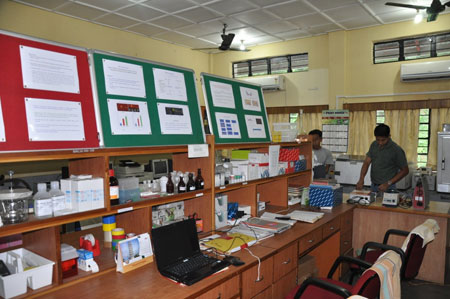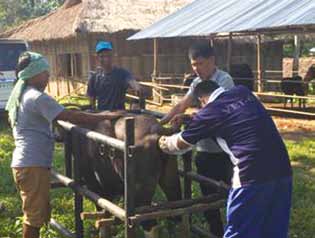Animal Physiology and Reproduction
 Conservation and propagation of mithun germplasm and augmentation of fertility are the core area of research. Artificial Insemination (AI) protocol standardized by the section and is being used successfully under farm as well as in field conditions. Successfully developed superovulation and ETT protocol for Mithun and produced first embryo transfer calf ‘BHARAT’ on 27th March 2012. This section hosted one Post Doctorate, five Doctorate and four Post Graduate Scholars in the last 5 five years. Currently, research on standardization of cryopreservation protocol using the controlled freezing technique, improvement in the quality of the cryopreserved semen using additives and selection of bulls for breeding purposes through breeding soundness evaluation and endocrine profiling is under progress. Estrus synchronization with timed AI and early induction of puberty in pre-pubertal heifers through the administration of neuropeptide ‘kisspeptin” has been standardized. Studies are also being carried out to compare the reproductive efficiency of bulls during different seasons. Since, August 2016, artificial insemination (AI) has been introduced in the Mithun Farm of Medziphema.
Conservation and propagation of mithun germplasm and augmentation of fertility are the core area of research. Artificial Insemination (AI) protocol standardized by the section and is being used successfully under farm as well as in field conditions. Successfully developed superovulation and ETT protocol for Mithun and produced first embryo transfer calf ‘BHARAT’ on 27th March 2012. This section hosted one Post Doctorate, five Doctorate and four Post Graduate Scholars in the last 5 five years. Currently, research on standardization of cryopreservation protocol using the controlled freezing technique, improvement in the quality of the cryopreserved semen using additives and selection of bulls for breeding purposes through breeding soundness evaluation and endocrine profiling is under progress. Estrus synchronization with timed AI and early induction of puberty in pre-pubertal heifers through the administration of neuropeptide ‘kisspeptin” has been standardized. Studies are also being carried out to compare the reproductive efficiency of bulls during different seasons. Since, August 2016, artificial insemination (AI) has been introduced in the Mithun Farm of Medziphema.
- The first mithun calf(Mohan) was born through embryo transfer technology (ETT) from a cryopreserved embryo at the National Research Centre on Mithun on 12th May 2012
- World’s first-ever mithun calf (Bharat) through embryo transfer technology was born at the National Research Centre on Mithun on 27th March 2012
- Sensitive ELISA procedures for estimating growth hormone (GH), LH, estradiol-17β, total estrogen, prolactin, PGFM and oxytocin in mithun plasma have been developed and validated
- A sensitive radioimmunoassay procedure of estimating progesterone in unextracted mithun plasma has been developed and validated.
- Secretion pattern of GH in growing mithun has been established and the relationship of high plasma GH level with age and body weight of mithun has been established
- Secretion pattern of LH in growing mithun has been established
- Twenty-four-hour rhythmicity of GH in adult mithun has been established
- Twenty-four-hour secretion pattern of LH in female mithun has been established

- Effect of exogenous GH-releasing hormone administration on pattern of LH secretion in growing mithun has been investigated
- Diurnal changes in blood metabolites and their relation to plasma GH and feeding time in mithun heifer have been established
- The relationship between plasma GH concentration and temperamental behaviour in mithun has been established
- The optimum dosages of GH-releasing factor for enhancement of growth in mithun calves have been standardised
- Changes in plasma prolactin and oxytocin during the milk letdown process in mithun cows have been established
- Peripheral plasma concentration of estradiol-17β, progesterone, LH, GH and prolactin during the oestrous cycle especially during the peri-oestrous period in mithun has been established
- Changes in the concentration of non-esterified fatty acid, glucose and α-amino nitrogen and their relationship with GH, estradiol-17β in cyclic mithun have been established
- The possible causes of silent estrus in mithun has been defined
- Different estrus/ovulation synchronization protocols in using prostaglandin, progesterone, estrogens, gonadotropins or their combination have been standardized for mithun
- The role of oxytocin on the development of mother-neonate bond in mithun has been investigated
- Detection of the transcripts of fertility associated antigens(heparin-binding protein and osteopontin) in mithun seminal plasma and its association with semen quality have been done
- Suitable superovulation protocols for embryo transfer in mithun have been standardized




























